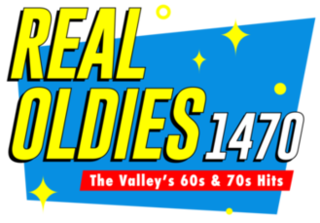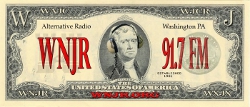
WWKB is a commercial radio station in Buffalo, New York. It broadcasts a sports betting radio format and is owned and operated by Audacy, Inc. It is one of two sports radio stations owned by Audacy in the Buffalo radio market, with WGR primarily broadcasting local sports programming. The studios are on Corporate Parkway in Amherst, New York.
WGPR is a commercial radio station in Detroit, Michigan, broadcasting an urban contemporary radio format. Owned by the International Free and Accepted Modern Masons, its studios and offices are on East Jefferson Avenue on Detroit's lower eastside.

KSL Newsradio is a pair of radio stations serving the Salt Lake City, Utah region, consisting of the original AM station, KSL, licensed to Salt Lake City on 1160 kHz, and FM station KSL-FM, licensed to Midvale on 102.7 MHz. Owned by Bonneville International, a broadcasting subsidiary of the Church of Jesus Christ of Latter-day Saints, the stations share studios with sister television station KSL-TV in the Broadcast House building at the Triad Center in downtown Salt Lake City.
WQXR-FM is an American non-commercial classical radio station, licensed to Newark, New Jersey and serving the North Jersey and New York City area. It is owned by the nonprofit organization New York Public Radio, which also operates WNYC AM and FM and the four-station New Jersey Public Radio group. WQXR-FM broadcasts from studios and offices located in the Hudson Square neighborhood in lower Manhattan and its transmitter is located at the Empire State Building.

WBBR is a Class A clear-channel radio station licensed to New York City. It serves as the flagship station of Bloomberg Radio, Bloomberg L.P.'s radio service. The station offers general and financial news reports 24-hours a day, along with local information and interviews with corporate executives, economists, and industry analysts.

WSAN is a commercial radio station licensed in Allentown, Pennsylvania. It is owned by iHeartMedia and serves the Lehigh Valley radio market. It broadcasts an oldies radio format, with its studios and offices in the iHeart Broadcasting Center in Whitehall Township. It is the oldest station in the Lehigh Valley.

WJLB is a commercial radio station in Detroit, Michigan. Owned by iHeartMedia, it broadcasts an urban contemporary radio format. The studios are on Halsted Road in Farmington Hills. In morning drive time, WJLB carries the syndicated Breakfast Club from co-owned WWPR-FM New York City.
WWRL is a commercial radio station licensed to New York City. WWRL airs an all-news radio format as an affiliate of the Black Information Network (BIN). The station is owned by iHeartMedia, Inc.

WZRC, known on-air as "AM1480", is a radio station licensed to New York City. The station is owned by Multicultural Broadcasting and airs Cantonese programming. It is one of two Cantonese radio stations serving the New York metropolitan area, the other is Chung Wah Chinese Broadcasting Company. WZRC's transmitting facility is located in Ridgefield Park, New Jersey.
WTLC is a commercial AM radio station in Indianapolis, Indiana. It is owned by Urban One and broadcasts an urban gospel radio format, with some Christian talk and teaching shows heard middays and afternoons. The studios and offices are downtown at the corner of Meridian and St. Joseph Streets.
WOPG is an AM radio station licensed to Albany, New York and serving the Capital District. It is owned by Pax et Bonum, Inc. and has a Christian radio format aimed at Roman Catholic listeners, with much of its programming coming from the EWTN Radio network. WOPG simulcasts with WOPG-FM at 89.9 FM in Esperance, New York.

WSYR is a commercial AM radio station in Syracuse, New York and serving Central New York. Owned and operated by iHeartMedia, it broadcasts a news/talk format, calling itself "Newsradio 570 WSYR." The station has simulcast on WSYR-FM 106.9 MHz Solvay since January 2011. The studios and offices are on Plum Street in Syracuse.
KMIC is an English language South Asian music and spoken word formatted broadcast radio station licensed to Houston, Texas, serving the Greater Houston area. The station, which began broadcasting in 1947, is owned and operated by DAIJ Media.
WLIM is a radio station licensed to Medford, New York, broadcasting a Spanish news–talk format.
KRKO is a commercial radio station licensed to Everett, Washington. The station broadcasts a classic hits radio format to the Seattle metropolitan area. The station was established in 1922, and is currently owned by S-R Broadcasting Co., Inc., a locally-based company.
WWRU is a commercial AM radio station licensed to Jersey City, New Jersey, broadcasting to the New York metropolitan area. It airs Korean language talk and music shows, with the studios in Manhattan.
WNYH is a radio station licensed to Huntington, New York, it serves the Long Island area and broadcasts brokered programming. The station is owned by Win Radio Broadcasting Corporation.

WNJR is a non-commercial FM radio station broadcasting a freeform radio format. Licensed to Washington, Pennsylvania, it serves Greater Pittsburgh's Southwest suburbs. The station is owned by Washington & Jefferson College.
Danny Stiles was a radio personality at WEVD-AM, WNYC, WNSW, WJDM and WPAT in the New York City market. He worked on the radio for 63 years in the New York City area, up to the time of his death.








